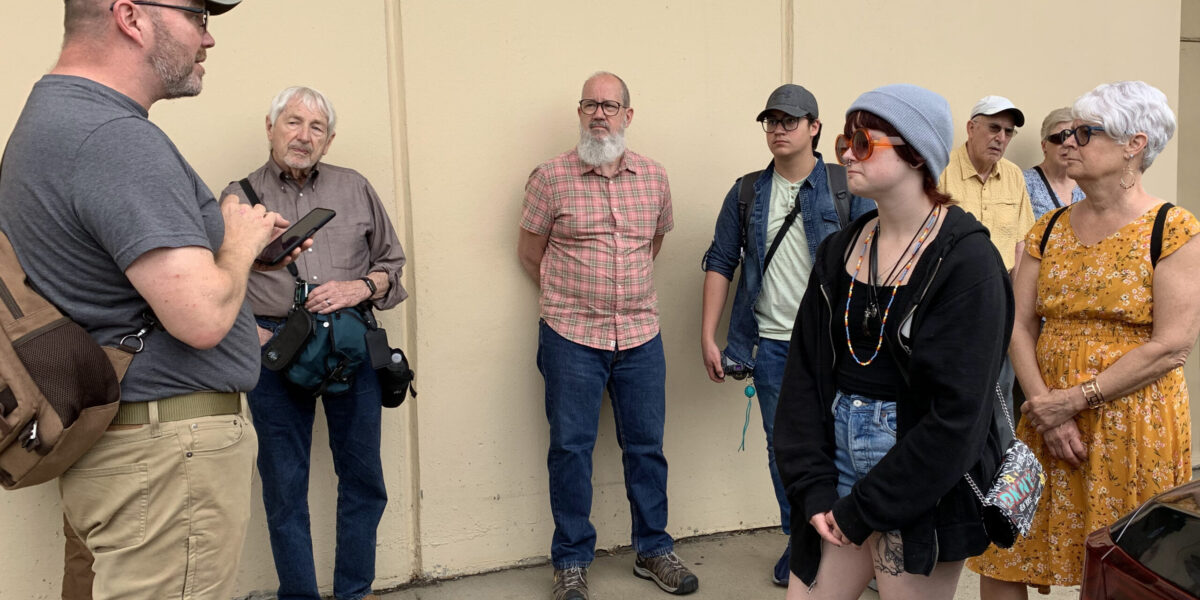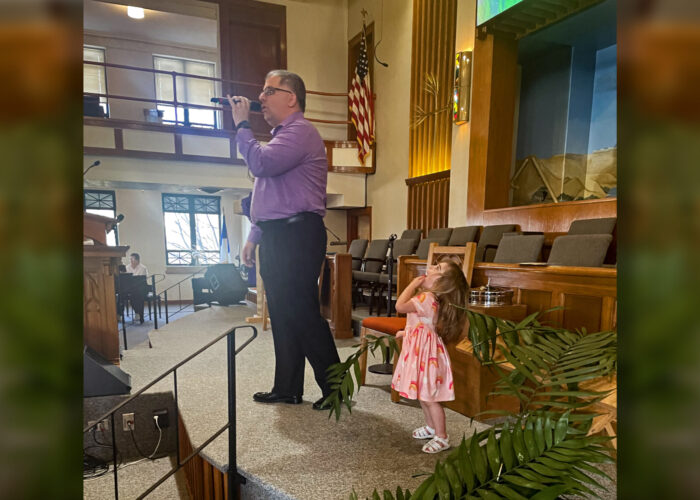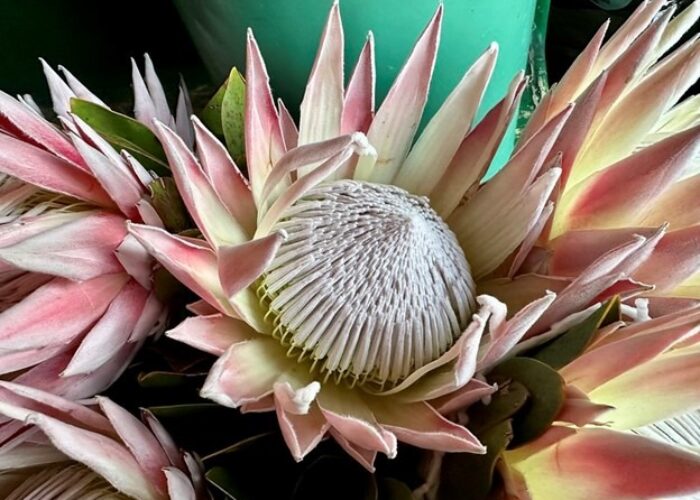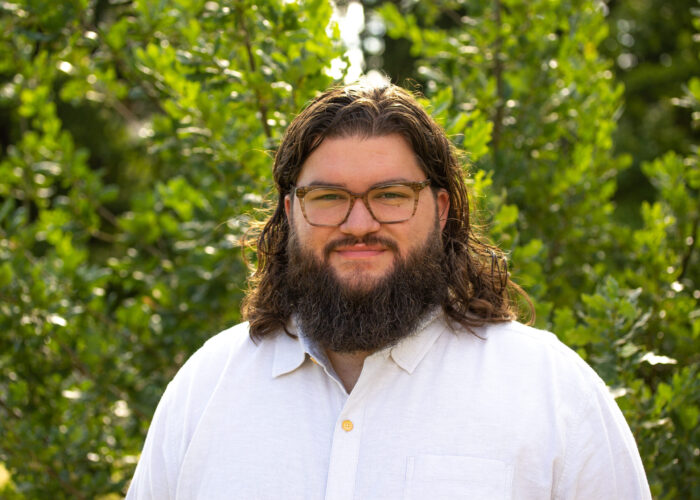Jennifer Murch participated in the Just Peace Pilgrimage Civil Rights Learning Tour in April 2023. Her thoughts are broken down into six blogs, spanning all seven days of the tour. Read days one and two here, day three here, day four here, and day five here.
Just Peace Pilgrimages are new group learning experiences through Mennonite Mission Network. For more information about upcoming pilgrimages, click here.
Day Six
We drove to Jackson, Mississippi, where we attended a service at Open Door Mennonite Church, a tiny congregation of super-friendly folks.
Afterward, we went to a restaurant for lunch — catfish, sweet potato fries, fried green tomatoes — with Pastor Horace, and then spent the afternoon at the Mississippi Civil Rights Museum.
At first, I wasn’t too excited. I was getting weary of absorbing information, and nothing quite compares to the EJI museum (Equal Justice Initiative, also known as the Legacy Museum in Montgomery, Alabama)! But then I started digging into the displays, sitting for the movies, actually reading the information and trying to connect it to the stories I’d heard. After a week of being so focused on a theme, the bits of information were beginning to stack up, sort of like a Russian nesting doll of experiences. For example:
- Inside the Freedom Summer of 1964 were the freedom schools.
- Inside the freedom schools were lots of Black families who hosted Black and White college students who’d come to the south to teach the children and get people to register to vote.
- Inside the voter registration efforts were church bombings, murders (including the lynchings of the three civil rights workers), marches, protests, the Civil Rights Act of 1964 and the (1965) passage of the Voting Rights Act.
- And inside all those things were a handful of individuals doing small things — reading a book in a library, wading into the water at a Whites-only beach, registering to vote (click that last link and then scroll part way down the page for a sample literacy test!) — that, together, made up a movement.
In the Emmett Till display, I listened to a recording of a person working with the Emmett Till Interpretive Center who had been involved in the installation of a commemoration marker at the murder site. He told about an interaction he’d had with a man who’d been angry about the marker.
"Why are you bringing this stuff up now?" the man had demanded. "That’s in the past!"
But the worker, instead of getting angry, asked the man if he had children, and explained how helpful it can be to a grieving community when they can publicly remember what they have lost.
The man walked off without saying much, but the next day he returned. "My wife is a seamstress in a fabric store," he said. "If you’re going to have an unveiling of a marker, then you need a good piece of fabric. We’d like to contribute that for the ceremony."
"I could’ve called gotten upset and labeled that man a racist," the person concluded, "but I didn’t and look what happened."
Day Seven
For our last day, we toured Jackson with Pastor Hugh, a lifelong Southerner.
Hugh spoke slowly, rhythmically: sweeping stories bulked up with meaty facts. Thoughtful, meandering exposition punctuated with truth bombs. Roundabout answers that forced me to connect the dots myself. We’d only been with him for an hour or two before it occurred to me that it might be wise to take notes. So, I did (thank goodness).
Here are some of my main takeaways from our day with Hugh:
People won’t give you the tools you need to overthrow them.
At the fairgrounds, Hugh told us that back in the 60’s the 10-day event was divided into two fairs: nine days were for White people, and one was for Blacks. When the Blacks protested (and I think this happened for a couple years running), the protestors were rounded up and caged in the fairground’s cattle barns — within view of the capitol building. At that time Mississippi law said that a person had 40 days to post bail, so the protestors leveraged that against the system: they’d get arrested and then wait to appeal their case until the 39th day, effectively clogging up the jails.
Silence doesn’t mean peace.
Hugh pointed out the old library where The Tougaloo Nine — students from Tougaloo College — held their read-in in 1961. It was a tiny event, but it effectively kickstarted the civil rights movement. At the time, Hugh explained, many White people didn’t even realize there was a race problem. "White culture confuses silence with peace, so the people who talk about the problem are assumed to cause the problem, when in reality the problem already existed."
Heroes versus Movements
We walked by the bus station where the Freedom Riders ended their journey. "You saw that wall of photos in the Civil Rights Museum yesterday, right? Of the 450 people that participated in the Freedom rides, did you notice that none — not one — of the people on that wall are famous? They were all just regular people who protested, did jail time, and then went back to doing whatever they were doing before — going to school or cooking food or farming."
Hugh asked if we were familiar with David LaMotte. "If you aren’t, you should be," he said, and then he explained told us what LaMotte says about heroes versus movements: Heroes are bigger than life, so if we always look for a hero to get the work done, then we won’t ever do anything — it feels too impossible. But a movement is made up of ordinary people; everyone gets to play a part.
The Banality of Evil
Black southern homes often have photos on the wall of the same three men — Abraham Lincoln, Martin Luther King, Jr., and John F. Kennedy — "but let me tell you something about Kennedy," Hugh said.
By the time the Freedom Riders were entering Mississippi, the whole world was watching, and the violence was making Kennedy look bad. So right before the bus entered Mississippi, Kennedy struck a deal with state authorities: in exchange for providing police protection for the riders, he wouldn’t intervene when state officials arrested and jailed the protestors. In other words, as long as the state made Kennedy look good on the news, they could do whatever they wanted in private.
Did this mean Kennedy was a horrible person? Not really, Hugh said. Governments are about compromise. Kennedy’s face-saving deal at the expense of the Freedom Riders didn’t necessarily mean Kennedy was a bad person, or even racist. "People make the best decisions they can at the time based on the opportunities they think they have."
Evil isn’t just a few monsters doing all the terrible things, Hugh said. In fact, there might not be any monsters. Rather, evil is the accumulation of thousands of small compliances that enable evil to happen — and may make room for monsters to emerge. This, Hugh explained, is called The Banality of Evil, and the converse, the Banality of Good, also exists: lots of small positive acts that enable great goodness.
History doesn’t repeat, it rhymes.
Hugh led us down Farish street, the section of town that was the heart of Jackson’s Black community in the 1960s. He pointed out Peaches, the restaurant that MLK loved, and the Alamo Theater, and the building that at different points had housed the headquarters for everything that was anything: NAACP (National Association for the Advancement of Colored People), SNCC (Student Nonviolent Coordinating Committee), COFO (Council of Federated Organizations), and a whole bunch of other things I can’t remember now.
Farish Street is now deserted — the unintended consequence of desegregation was the collapse of the Black middle class, Hugh said, echoing the same theme we’d been hearing all week — but a few years back, the city obtained funding to restore Farish street. They put in trees and redid the road and sidewalks, but then the money vanished, pocketed by investors and contractors, and now Farish Street is lost once again: a partially-revitalized ghost town, twice abandoned.
"History doesn’t repeat itself," Hugh said, paraphrasing Twain, "It rhymes."
A movement is comprised of ordinary people doing small things.
On Farish Street, Hugh pointed out the building that used to be the YWCA. He told us about how when there’d been a children’s march and the police were rounding them up, a few of the kids ran into the building to hide. When the police tried to go in after them, the woman in charge, a large Black woman, refused them entry — This building is for women, she said. Men aren’t allowed. , The police listened. "I’ve heard that story many times," Hugh said, "and you know what? No one knows that woman’s name."
 Southern buffet: catfish, hushpuppies, ribs, stuffing, butter beans, cabbage, sweet potatoes, greens, and summer squash.
Southern buffet: catfish, hushpuppies, ribs, stuffing, butter beans, cabbage, sweet potatoes, greens, and summer squash.
The rest of our country needs a Mississippi to make it feel better about itself.
We circled an enormous mall that was the hub of consumerism back in the 80s and is now completely abandoned, except for one little corner that, rather ironically, houses the Jackson City Water Offices. (The mall bore such an uncanny resemblance to parts of Station Eleven that I googled it to see if they’d filmed there — they hadn’t.) We drove through the fancy part of town and through a food desert. Twenty-five percent of Jackson’s population has an annual income of fifteen thousand dollars.
At one point, after a series of questions about what Jackson’s future might hold, the strain of living surrounded by such poverty and racial tensions, Hugh said, "Hang on a sec. Aren’t y’all from Virginia?"
And then my older daughter pointed out that we hadn’t seen hardly any Confederate flags on this trip but they’re everywhere in Virginia.
Goodness and evil, side-by-side
At the home of Medgar Evers, the civil rights activist who was murdered in 1963, Hugh told us how Evers had had the house built to his specification: a gravel roof so it’d be easier to put out the fires in case it’d be fire-bombed (which it was). A brick wall that rose a certain number of inches above the height of the children’s beds, so they’d be protected from gunfire while they were sleeping. A side door instead of a front door. A fridge on wheels positioned beside the kitchen door so it could double as a barricade.
Hugh pointed to the spot where the gunman had been standing when he shot Evers as he was unloading some things from the trunk of his car. The next-door neighbor had come to Evers’ rescue, loaded him into the car, and rushed him to the hospital. But it was against hospital rules for Blacks to be treated by White staff. Evers’ wife had called their family doctor, a Black man, but when he arrived, he wasn’t allowed to use the hospital equipment. Eventually, the head doctor arrived and said he’d take responsibility for breaking the rules, but by then it was too late.
"And here’s the thing," Hugh said. "Twenty-four hours earlier in that very same hospital, doctors had just successfully performed the first lung transplant. That evil and goodness coexisting side-by-side pretty much sums up Jackson."
Broken bodies, breaking bread
That evening we met back at Open Door church for a catered feast of potato salad, pasta and chicken, green beans, cornbread, three kinds of cake, and sweet tea made by a 15-year-old girl, and then Hugh led us in a closing reflection.
He told us that when the protestors were caged in the cattle pens at the fairgrounds, the officers made the White and Black protestors sit on opposite sides of the pens. The guards fed the White protestors first, but the most amazing thing happened: Each person, without speaking, took their cup of milk and set it on the ground in front of them, placed their bologna sandwich on top, and waited. Then the Blacks were served, and they did the same. The two groups sat there silently, facing each other, and when everyone had been served, the Whites and Blacks quietly, and as one body, ate together.
"This might be heretical," Hugh said, "but I believe Jesus has already returned — and his body has been lynched and burned and broken again and again and again."
And then he served us communion with sweet tea and cornbread left over from our dinner.











